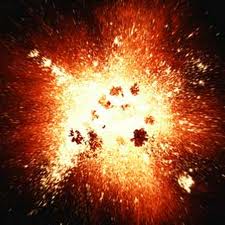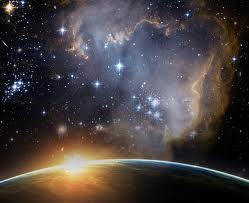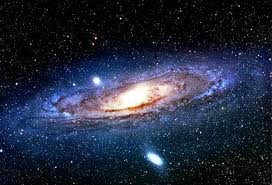There are many scientist debating about the origin of the Universe. Just like the famous scientist named Einstein.
Origin of the Universe - The Big Bang Theory
 Most scientists now believe that the answer to the first part of the question is that the Universe sprang into existence from a singularity -- a term physicists use to describe regions of space that defy the laws of physics. We know very little about singularities, but we believe that others probably exist in the cores of black holes.
Most scientists now believe that the answer to the first part of the question is that the Universe sprang into existence from a singularity -- a term physicists use to describe regions of space that defy the laws of physics. We know very little about singularities, but we believe that others probably exist in the cores of black holes.The second part of the question, as to what existed before the Big Bang, has scientists baffled. By definition, nothing existed prior to the beginning, but that fact creates more questions than answers.Once the singularity was created (however it happened), it began to expand through a process called inflation. The Universe went from very small, very dense, and very hot to the cool expanse that we see today. This theory is now referred to as the Big Bang, a term first coined by Sir Fred Hoyle during a British Broadcasting Corporation radio broadcast in 1950.
Interestingly, there really wasn’t any sort of explosion or bang as the name suggests, but rather the rapid expansion of space and time. It is like blowing up a balloon, as you blow air in, the exterior of the balloon expands outward.
Some of the other theories argue that the Big Bang theory is based on a false premise -- that the Universe is built on an ever expanding space-time. Some, instead, prefer to build theories on a static Universe, which is what was originally predicted by Einstein’s theory of general relativity. Einstein’s theory was only later modified to accommodate the way the Universe appears to be expanding.
 Origin of the Universe - The Inflation Universe Theories
Origin of the Universe - The Inflation Universe TheoriesThe Big Bang Theory provided an atheistic explanation for the origin of the universe, but its obvious simplicity was subject to multiple attacks. As a result, the original theory is no longer the dominant scientific explanation for the atheistic origin of the universe. While the original Big Bang Theory is now "dead," from its ashes have emerged the various Inflationary Universe Theories
.
Origin of the Universe - Theism vs. Atheism
In general, theists attribute the origin of the universe to some sort of transcendent, intelligent Designer. Atheists envision a natural, undirected process by which universes spring into existence spontaneously. Prior to the 20th century most atheists believed the universe was eternal. This changed however as discoveries throughout the 20th Century rendered that view untenable. Einstein’s theory of gravity which has been thoroughly validated by extensive experimental confirmation and Hubble’s astronomical observations preclude an eternal universe. We now know beyond a reasonable doubt that the universe began at some point in the finite past.
 Origin of the Universe - Long Ago and Far Away...
Origin of the Universe - Long Ago and Far Away...Attempts to exclude a Creator from the "origin of the universe equation" have been long on theoretical calculations and short on common sense. The various models merely move the questions of where, why and how did everything get here to "long ago and far away." Atheists are tenacious in their efforts to ignore the necessity of a First Cause, Intelligent Designer, Creator God. But as Aldous Huxley put it so eloquently, "Facts do not cease to exist because they are ignored." And it seems that atheists must ignore a great deal in order to maintain their atheistic cosmogonic position.
The explanation in the top is the explanation of the theory how Universe created or the Origin of the Universe. All we know is only God created all the system the we found anywhere. Maybe scientist did not believed about God so they searching in their own to find the origin of Universe.




